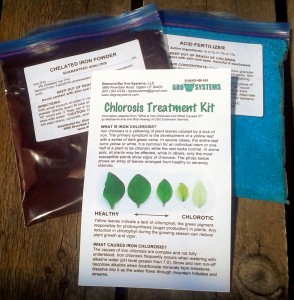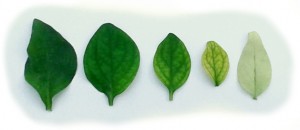
Diamond Bar Gro-Systems has a new product: The Chlorosis Treatment Kit.
WHAT IS CHLOROSIS?
Iron chlorosis is a yellowing of plant leaves caused by a lack of iron. The primary symptom is the development of a yellow leaf with a series of dark green veins. In severe cases, the entire leaf turns yellow or white. It is common for an individual stem or one half of a plant to be chlorotic while the rest looks normal. In some pots, all plants may be affected, while in others, only the most susceptible plants show signs of chlorosis. The photo below shows an array of leaves arranged from healthy to severely chlorotic.
Yellow leaves indicate a lack of chlorophyll, the green pigment responsible for photosynthesis (sugar production) in plants. Any reduction in chlorophyll during the growing season can reduce plant growth and vigor.
WHAT CAUSES IRON CHLOROSIS?
The causes of iron chlorosis are complex and not fully understood. Iron chlorosis frequently occurs when watering with alkaline water (pH level greater than 7.0). Snow and rain run-off becomes alkaline when bicarbonate minerals from limestone dissolve into it as the water flows through mountain hillsides and streams.
Most vegetable plants and plants native to alkaline soils usually don't suffer from iron chlorosis if they are regularly fertilized. Unfortunately, most hybrid trailing plants are non-native and require consistent pH conditions below 6.
Even though there is plenty of iron in the regular Diamond Bar fertilizer, certain conditions can cause chlorosis, making iron unavailable to plant roots, including 1) under-fertilizing and 2) over-watering.
UNDER-FERTILIZING
Under-fertilizing occurs when plants are fertilized irregularly, infrequently, or insufficiently. This is especially common during cooler weather when plants are small and use the water more slowly.
To prevent this, fill the reservoir only partially instead of to overflowing so the potting mix dries out more often, but still use the same amount of fertilizer as if filling the reservoir full. Using the 16'' round pot as an example: put only 1 gallon of water in the reservoir (instead of 2), but still use the full 2 oz. of fertilizer once every 5-10 days, depending on plant size.
OVER-WATERING
Over-watering can result from topping off the reservoir before the potting mix has dried out, neglecting to use the dipstick, adding extra water from automatic sprinklers or roof runoff, and/or an over-abundance of rain. Ideally, the reservoir should dry out at least every 4-5 days.
If plants take longer to use the water, fill the reservoir only half-way instead of to overflowing. It may even be necessary to dump out the reservoir water through the drain-spout by tilting the pot drain-side down during persistent wet period, allowing the potting mix to dry out.
TREATMENT FOR CHLOROSIS
The occasional use of special acid fertilizer and water-soluble chelated iron (a form of iron which plants can absorb) combined with careful watering and fertilizing can green up chlorotic plants in 2-3 weeks.■


Better Quality ~
Less Maintenance